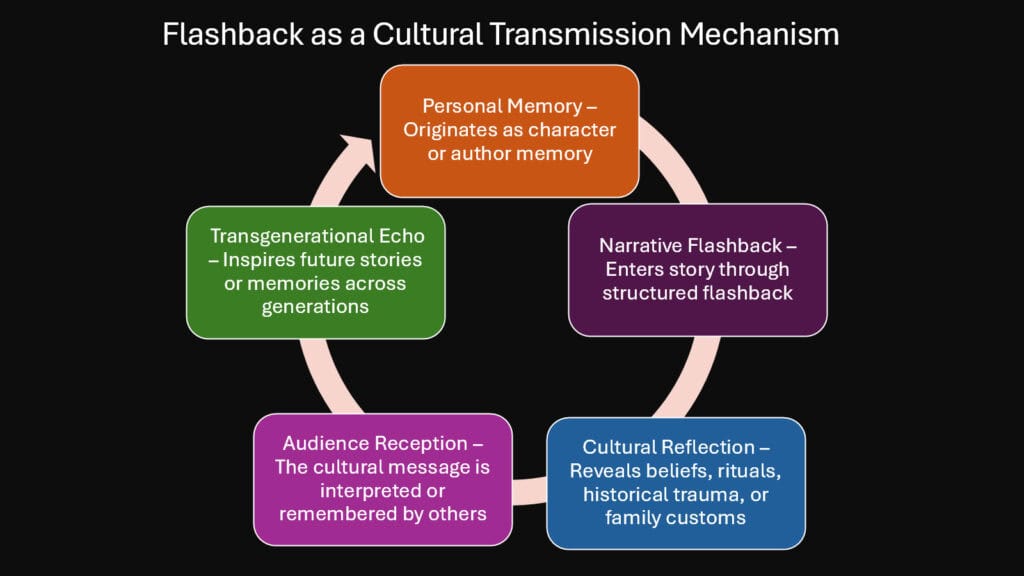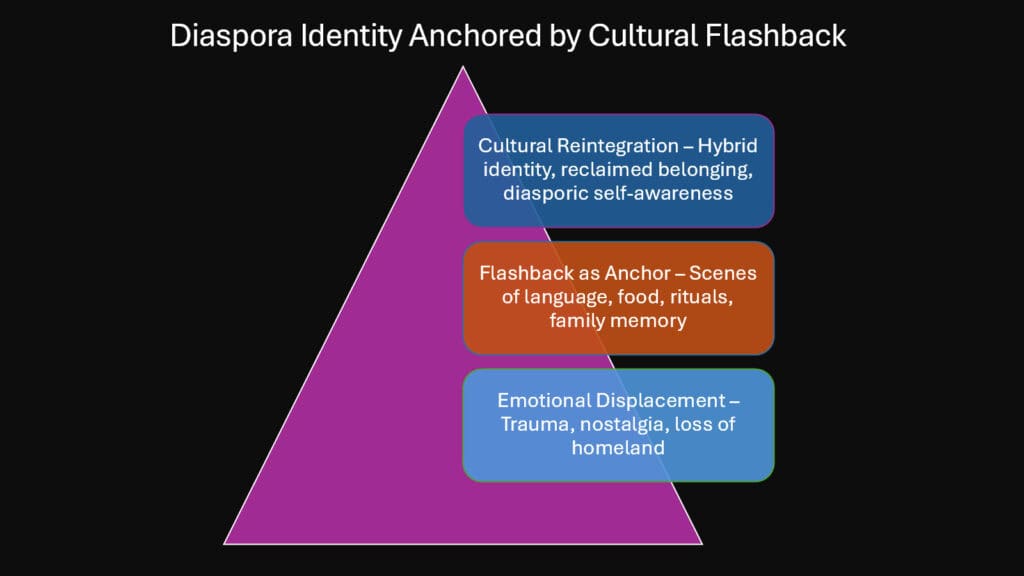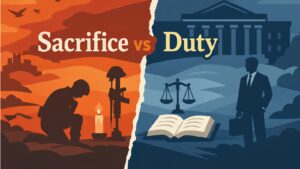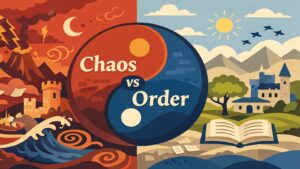Table of Contents
Introduction: Flashbacks as a Cultural Thread in Storytelling

When Homer recounted the fall of Troy through Odysseus’s memories, he understood something profound about human nature. Stories carry more than plot – they transport entire worlds of meaning across generations. The flashback stands as one of literature’s most enduring techniques, weaving through narratives like golden thread through ancient tapestry. From the Sanskrit epics of India to the warrior tales of medieval Japan, flashbacks have served as vessels for cultural transmission, carrying forward the wisdom, trauma, and dreams of civilizations.
The flashback functions as more than mere narrative device. It operates as cultural DNA, encoding the essential experiences that define communities and preserve their identity through time. When Vyasa composed the Mahabharata, his intricate web of memory sequences did not simply tell a story – they created a repository of dharmic wisdom, political philosophy, and social structure that would guide Indian civilization for millennia. Similarly, when the anonymous composers of Heike Monogatari used flashbacks to recall the glory and fall of the Taira clan, they were crafting a cultural compass that would help Japanese society navigate questions of honor, impermanence, and social order.
These narrative time-shifts bridge vast chasms – between past and present, between individual and collective memory, between one culture and another. They function as cultural ambassadors, carrying messages across linguistic boundaries and temporal distances. The flashback allows stories to become living entities, breathing repositories of human experience that adapt and evolve while maintaining their essential cultural core.
This exploration reveals six fascinating ways flashbacks serve as cultural bridges. They transmit collective memories across generations, preserve oral traditions in written forms, reflect non-linear concepts of time, reclaim suppressed histories in postcolonial narratives, anchor diasporic identities to their origins, and weave mythic consciousness into modern experience. Each function demonstrates how flashbacks transform storytelling from entertainment into cultural preservation and transmission.
Table 1: Flashbacks Across Cultural Traditions
| Literary Tradition | Primary Function | Cultural Purpose | Temporal Structure |
|---|---|---|---|
| Sanskrit Epic | Dharmic Teaching | Moral Guidance | Cyclical Time |
| Greek Epic | Heroic Memory | Cultural Identity | Linear Recall |
| Japanese Monogatari | Aesthetic Reflection | Social Values | Seasonal Cycles |
| Celtic Mythology | Ancestral Wisdom | Tribal Memory | Sacred Time |
| African Oral Tradition | Community Knowledge | Survival Skills | Generational Loops |
| Aboriginal Dreamtime | Spiritual Teaching | Land Connection | Eternal Present |
1. Flashbacks as a Tool of Collective Memory Transmission
Cultural memory operates differently from personal recollection. While individual memories fade and distort, collective memories crystallize into stories that carry forward the essential experiences of entire peoples. Flashbacks serve as the primary mechanism through which cultures transmit their deepest truths, transforming private moments into shared inheritance.
The Mahabharata demonstrates this principle magnificently. When Vyasa structures his epic through multiple layers of storytelling – Vaishampayana recounting to Janamejaya what Vyasa told him, with numerous flashbacks within flashbacks – he creates what cultural memory theorist Maurice Halbwachs would recognize as collective memory frameworks. These nested recollections do not merely entertain; they encode legal principles, philosophical debates, and social structures that would guide Indian civilization.
Similarly, the Iliad employs flashbacks not just to reveal character backgrounds but to transmit the heroic code that defined Greek aristocratic culture. When Achilles recalls his conversations with his mother Thetis, or when Phoenix remembers raising the young hero, these memories carry forward concepts of honor, loyalty, and divine relationship that shaped Greek identity for centuries. The flashbacks function as cultural genes, replicating essential information across generations.
Cultural Memory Studies, as developed by scholars like Jan and Aleida Assmann, recognizes how societies create communicative memory through everyday interaction and cultural memory through institutionalized practices. Flashbacks in epic literature serve both functions simultaneously. They preserve specific cultural knowledge while creating frameworks for ongoing cultural transmission. The memory sequences become teaching tools, allowing each generation to internalize cultural values through narrative engagement.
Contemporary examples continue this tradition. Toni Morrison’s use of flashbacks in Beloved creates what she calls “rememory” – a collective processing of traumatic experience that allows communities to heal while preserving essential knowledge. The technique transforms individual trauma into collective wisdom, demonstrating how flashbacks serve ongoing cultural needs.
Table 2: Collective Memory Functions in Literature
| Memory Type | Literary Function | Cultural Impact | Transmission Method |
|---|---|---|---|
| Ancestral Wisdom | Moral Teaching | Value Formation | Elder Narration |
| Traumatic Experience | Healing Process | Community Resilience | Ritual Recounting |
| Foundational Myths | Identity Creation | Cultural Cohesion | Sacred Stories |
| Historical Events | Lesson Preservation | Political Guidance | Commemorative Tales |
| Social Customs | Behavioral Modeling | Norm Maintenance | Generational Teaching |
| Spiritual Insights | Transcendent Connection | Meaning Making | Mystical Narratives |
2. Flashbacks: Bridging Oral Tradition and Written Word

The transition from oral to written culture represents one of humanity’s most significant evolutionary leaps. Flashbacks serve as crucial bridges in this transformation, preserving the rhythmic, cyclical nature of spoken storytelling within written narrative style and structures. They maintain the living quality of oral tradition while adapting to the permanence of written form.
Oral cultures organize memory differently than literate societies. Traditional storytellers employ circular narrative patterns, returning repeatedly to key themes and images. The Odyssey exemplifies this bridge function perfectly. Homer’s epic, though eventually written down, preserves the oral tradition’s repetitive, cyclical structure through its extensive use of flashbacks. When Odysseus recounts his adventures to the Phaeacians, the narrative mirrors the way oral poets would return to familiar stories, each telling adding new layers of meaning.
The Japanese Heike Monogatari demonstrates similar bridging functions. Originally performed by blind biwa priests, the tale uses flashbacks to create the circular, meditative quality of oral performance. The persistent recollections of former triumphs and current deterioration reflect the cyclical, seasonal characteristics of conventional Japanese narratives. When transformed into written form, these flashback structures preserve the contemplative, cyclical quality of the original oral performances.
African American literary traditions show how flashbacks maintain oral culture’s communal quality within individual reading experiences. Writers like Charles Chesnutt and later Zora Neale Hurston use flashback structures that echo call-and-response patterns, creating written narratives that retain the participatory energy of oral storytelling. The technique allows readers to experience the collective wisdom-making process of traditional oral communities.
Celtic mythology utilizes flashbacks to uphold the spiral time principles inherent in druidic oral traditions. Narratives such as the Ulster Cycle incorporate memory sequences that revisit earlier generations, thereby preserving the interconnected, non-linear essence of oral storytelling. These written versions preserve the oral tradition’s understanding of time as layered and recursive rather than simply chronological.
Table 3: Oral-to-Written Transition Elements
| Oral Feature | Written Adaptation | Cultural Preservation | Modern Application |
|---|---|---|---|
| Repetitive Patterns | Recurring Flashbacks | Mnemonic Structures | Contemporary Poetry |
| Cyclical Narrative | Spiral Time Sequences | Seasonal Consciousness | Literary Fiction |
| Communal Voice | Multiple Perspectives | Collective Wisdom | Polyphonic Novels |
| Rhythmic Speech | Prose Rhythm | Musical Language | Stream of Consciousness |
| Interactive Elements | Reader Engagement | Participatory Culture | Hypertext Literature |
| Sacred Formulas | Ritual Language | Spiritual Transmission | Magical Realism |
3. Flashbacks in Non-Linear Time Cultures
Western literary criticism often treats flashbacks as disruptions of chronological order, but many cultures understand time itself as non-linear. For these traditions, flashbacks do not break temporal flow – they align narrative structure with cultural concepts of time as cyclical, spiral, or multidimensional. Paul Ricoeur’s Narrative Time Theory helps illuminate how these different temporal understandings shape storytelling techniques.
Hindu and Buddhist traditions conceive time as cyclical rather than linear. The Mahabharata reflects this understanding through its complex flashback structure, where past events continuously influence present actions across multiple lifetimes. The epic’s time-shifts mirror the concept of karma, where past actions create present consequences in endless cycles. Vyasa’s narrative technique embodies the cultural understanding that time curves back upon itself, making past and present simultaneously accessible.
Indigenous American storytelling traditions often employ what Native scholars call “sacred time” – a temporal dimension where all moments exist simultaneously. Flashbacks in these narratives do not represent linear recalls but movements between different layers of time. Stories move fluidly between ancestral time, mythic time, and contemporary time, reflecting cosmologies where these temporal dimensions intersect rather than succeed each other.
Japanese aesthetic traditions, influenced by Buddhist concepts of impermanence, use flashbacks to create what might be called “seasonal time.” The Heike Monogatari employs memory sequences that mirror natural cycles, where past events return like seasonal patterns. The narrative’s flashback structure reflects the Buddhist understanding that all phenomena arise and pass away in endless cycles, making linear chronology less significant than cyclical patterns.
Aboriginal Australian storytelling operates within “Dreamtime” – a temporal dimension where mythic events continuously create the present world. Flashbacks in these narratives access this ongoing creative time, where ancestral actions continuously shape contemporary reality. The technique aligns with cultural understandings that past, present, and future exist simultaneously within the eternal Dreamtime.
Ricoeur’s analysis of narrative temporality recognizes how different cultures configure the relationship between lived time and cosmic time. Flashbacks serve as technical means for aligning narrative structure with these cultural time concepts, creating stories that feel natural within their originating worldviews while potentially challenging readers from different temporal traditions.
Table 4: Cultural Time Concepts and Narrative Structure
| Time Concept | Cultural Origin | Narrative Technique | Temporal Experience |
|---|---|---|---|
| Cyclical Time | Hindu-Buddhist | Karmic Flashbacks | Eternal Return |
| Sacred Time | Indigenous American | Mythic Intersections | Simultaneous Presence |
| Seasonal Time | Japanese Buddhist | Natural Rhythms | Impermanent Cycles |
| Dreamtime | Aboriginal Australian | Continuous Creation | Eternal Present |
| Spiral Time | Celtic Mythology | Generational Loops | Ascending Circles |
| Eternal Time | Platonic Tradition | Philosophical Reflection | Timeless Truth |
4. Flashbacks as Cultural Reclamation in Postcolonial Narratives
Colonial powers systematically suppressed indigenous narratives, replacing local histories with imperial versions of events. Postcolonial writers use flashbacks as tools of cultural reclamation, retrieving suppressed voices and challenging dominant historical narratives. These memory sequences function as acts of resistance, restoring agency to colonized peoples and reconnecting contemporary communities with their cultural roots.
Caribbean writer Jean Rhys demonstrates this technique powerfully in Wide Sargasso Sea. Her flashbacks reclaim the story of Bertha Mason from Charlotte Bronte’s Jane Eyre, transforming the “madwoman in the attic” into Antoinette Cosway, a Creole woman destroyed by colonial racism and patriarchal oppression. Rhys uses memory sequences to reveal the colonial violence hidden beneath the civilized surface of Victorian literature, reclaiming Caribbean experience from imperial misrepresentation.
Nigerian author Chinua Achebe employs flashbacks throughout his Okonkwo trilogy to restore precolonial Igbo society’s complexity and dignity. Rather than accepting colonial characterizations of African societies as primitive, Achebe’s memory sequences reveal sophisticated political, religious, and social systems. The flashbacks function as archaeological tools, excavating cultural knowledge buried beneath colonial stereotypes.
Indian writer Amitav Ghosh uses flashbacks to recover histories erased by both colonial and postcolonial nationalism. His Ibis trilogy employs memory sequences to reveal the multicultural, multilingual reality of Indian Ocean societies, challenging simplified narratives of both imperial exploitation and nationalist resistance. The technique recovers the complexity of colonial encounter, revealing agency and resistance within apparent victimization.
South African writer J.M. Coetzee demonstrates how flashbacks can expose the psychological violence of apartheid while recovering suppressed African perspectives. His memory sequences reveal how colonial education and Christian missions functioned as cultural weapons, while simultaneously showing the resilience and creativity of African responses to cultural assault.
These postcolonial flashbacks differ fundamentally from nostalgic memory. They function as acts of cultural archaeology, excavating suppressed knowledge and revealing hidden connections. The technique transforms personal memory into political action, using individual recollection to challenge collective amnesia about colonial violence and indigenous resistance.
Table 5: Postcolonial Flashback Functions
| Reclamation Type | Literary Function | Cultural Impact | Resistance Method |
|---|---|---|---|
| Historical Correction | Narrative Revision | Truth Recovery | Counter-Memory |
| Voice Restoration | Character Agency | Identity Reclaim | Testimony |
| Language Recovery | Linguistic Mixing | Cultural Preservation | Code-Switching |
| Ritual Revival | Spiritual Practice | Sacred Continuity | Ceremonial Memory |
| Political Critique | Power Analysis | Consciousness Raising | Revolutionary Memory |
| Psychological Healing | Trauma Processing | Community Recovery | Therapeutic Narrative |
5. Flashbacks as Emotional Anchoring in Diasporic Literature

Displacement creates unique narrative challenges. Diasporic communities exist between worlds – physically present in new locations while emotionally connected to distant origins. Flashbacks serve as emotional anchors in these narratives, maintaining connections to homeland cultures while processing the experience of cultural displacement. Diaspora and Identity Theory, as developed by scholars like Homi Bhabha and Stuart Hall, illuminates how these memory sequences function.
Vladimir Nabokov’s work exemplifies diasporic flashback techniques. His memories of Russian aristocratic childhood create what he calls “aesthetic bliss” – moments of transcendent beauty that maintain a connection to lost cultural worlds. These flashbacks do not simply recall events but recreate the sensory and emotional textures of displaced cultural experiences. The technique allows Nabokov to preserve Russian literary culture while adapting to American literary contexts.
Caribbean diasporic writers in Britain and North America use flashbacks to maintain connections with island cultures while addressing metropolitan experiences of racism and displacement. Writers like Sam Selvon and V.S. Naipaul employ memory sequences that preserve Caribbean vernacular and social rhythms within metropolitan literary contexts. The technique creates hybrid narrative voices that reflect diasporic cultural mixing.
Asian American writers use flashbacks to connect with ancestral cultures while processing generational conflicts around assimilation and cultural preservation. Amy Tan’s work demonstrates how memory sequences can bridge linguistic and cultural gaps between immigrant parents and American-born children. The flashbacks translate cultural knowledge across generational and linguistic boundaries.
These diasporic flashbacks often employ what Bhabha calls “mimicry” – cultural translation that preserves essential meanings while adapting to new contexts. The technique creates what Hall identifies as “diaspora identities” – cultural formations that maintain connections with origins while continuously evolving through encounter with new environments.
Table 6: Diasporic Identity Formation Through Flashbacks
| Identity Challenge | Narrative Response | Cultural Function | Emotional Process |
|---|---|---|---|
| Geographic Distance | Homeland Memory | Cultural Maintenance | Nostalgic Connection |
| Linguistic Loss | Vernacular Recovery | Language Preservation | Linguistic Grief |
| Generational Gap | Ancestral Wisdom | Knowledge Transmission | Intergenerational Healing |
| Cultural Mixing | Hybrid Identity | Creative Adaptation | Identity Negotiation |
| Discrimination | Community Memory | Resistance Strategy | Solidarity Building |
| Assimilation Pressure | Cultural Assertion | Identity Maintenance | Authenticity Struggle |
6. Flashbacks: Blending Myth, History, and Modernity
Contemporary narratives face the challenge of connecting mythic consciousness with historical awareness and modern experience. Flashbacks serve as alchemical devices in these works, transforming disparate temporal materials into unified narrative visions. They allow writers to weave ancient wisdom into contemporary contexts while maintaining both mythic power and historical accuracy.
Gabriel Garcia Marquez skillfully employs this technique in One Hundred Years of Solitude. His flashbacks move fluidly between mythic time, historical time, and family time, creating what he calls “magical realism.” The memory sequences allow mythic consciousness to coexist with historical events, making ancient patterns visible within modern Latin American experience. The technique reveals how mythic structures continue operating within contemporary political and social realities.
Salman Rushdie employs similar flashback techniques to blend Indian mythological consciousness with modern historical experience. His memory sequences in works like Midnight’s Children allow Hindu and Islamic mythic patterns to intersect with contemporary political events, creating narratives that feel both ancient and urgently contemporary. The flashbacks function as cultural translation devices, making traditional wisdom accessible to modern readers while revealing mythic dimensions of contemporary experience.
African writers like Ben Okri use flashbacks to integrate traditional spiritual consciousness with modern African urban experience. His memory sequences allow ancestral wisdom and modern education to coexist within single narratives, creating what postcolonial critics call “decolonized consciousness.” This technique illustrates how traditional knowledge systems can shape modern African identity without necessitating the dismissal of contemporary education.
Native American writers employ flashbacks to maintain connections with traditional spiritual teachings while addressing contemporary reservation and urban experiences. Writers like Leslie Marmon Silko use memory sequences that allow sacred time to intersect with historical time, creating narratives that feel both traditionally grounded and contemporarily relevant.
These synthetic flashbacks create what might be called “mythic realism” – narrative modes that maintain connection with sacred consciousness while engaging contemporary realities. The technique allows ancient wisdom traditions to inform modern experience without becoming nostalgic retreat from contemporary challenges.
Table 7: Temporal Synthesis in Contemporary Literature
| Narrative Layer | Cultural Source | Literary Function | Contemporary Relevance |
|---|---|---|---|
| Mythic Consciousness | Sacred Tradition | Archetypal Pattern | Universal Meaning |
| Historical Memory | Documentary Record | Factual Foundation | Political Awareness |
| Personal Experience | Individual Life | Emotional Authenticity | Reader Connection |
| Cultural Knowledge | Community Wisdom | Social Understanding | Collective Identity |
| Spiritual Insight | Religious Tradition | Transcendent Dimension | Existential Meaning |
| Political Analysis | Contemporary Critique | Social Commentary | Cultural Transformation |
Conclusion: Flashbacks as a Cultural Compass Across Time and Borders

The flashback emerges from this exploration not merely as narrative technique but as cultural technology – a sophisticated mechanism for preserving, transmitting, and transforming human experience across temporal and geographical boundaries. Like ancient trade routes that carried more than goods, flashbacks transport entire worlds of meaning between cultures, generations, and consciousness states.
These memory sequences function as cultural DNA, encoding essential information within narrative structures that ensure transmission across time. When the Mahabharata uses nested flashbacks to preserve dharmic wisdom, when Heike Monogatari employs seasonal memory to maintain aesthetic consciousness, when contemporary postcolonial writers use reclaimed memory to challenge imperial narratives, they demonstrate the flashback’s power to serve cultural survival and evolution simultaneously.
The technique’s universality across cultures suggests something fundamental about human consciousness and cultural transmission. Ranging from oral traditions that safeguard tribal knowledge to written epics that encapsulate civilizational wisdom, and to modern literature that addresses global displacement, flashbacks fulfill consistent roles while adjusting to various cultural settings. They bridge not only temporal distances but cultural differences, allowing stories to carry meaning across linguistic, religious, and ideological boundaries.
Perhaps most significantly, flashbacks transform individual memory into a collective resource. They convert private recollection into shared inheritance, personal trauma into communal wisdom, and individual displacement into collective resilience. The technique demonstrates storytelling’s capacity to serve cultural healing and preservation simultaneously, making narrative art essential for human cultural survival.
Contemporary global culture faces unprecedented challenges around cultural preservation, intercultural communication, and identity formation within rapid change. The flashbacks demonstrated the capacity to bridge cultural differences while maintaining cultural specificity, offering valuable insights for navigating these challenges. Stories using flashback techniques can preserve endangered cultural knowledge while making it accessible to global audiences, maintain cultural identity while enabling intercultural dialogue, and honor traditional wisdom while addressing contemporary needs.
Flashbacks stand as a testament to storytelling’s power to serve human cultural evolution. More than entertainment or even art, these memory sequences function as cultural compasses, guiding human communities through the complex navigation between preserving essential knowledge and adapting to changing circumstances.
Table 8: Flashback Functions Across Cultural Contexts
| Cultural Function | Narrative Mechanism | Human Need Served | Future Application |
|---|---|---|---|
| Memory Preservation | Encoded Narrative | Cultural Continuity | Digital Archives |
| Identity Formation | Personal History | Psychological Security | Global Identity |
| Intercultural Bridge | Shared Experience | Cross-Cultural Understanding | International Literature |
| Trauma Processing | Collective Memory | Community Healing | Therapeutic Narrative |
| Wisdom Transmission | Teaching Story | Generational Learning | Educational Technology |
| Consciousness Evolution | Mythic Integration | Spiritual Development | Consciousness Studies |




